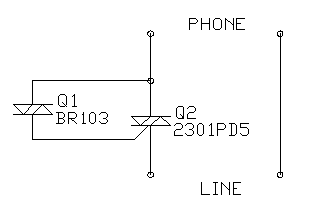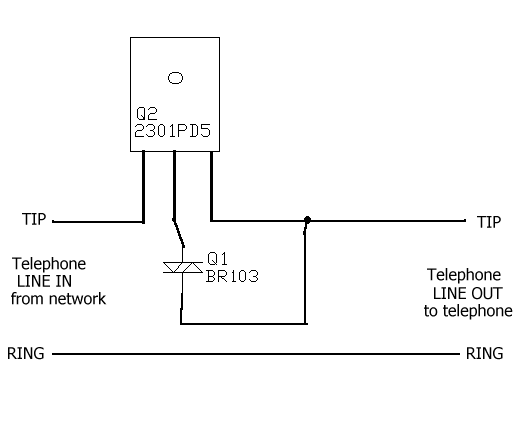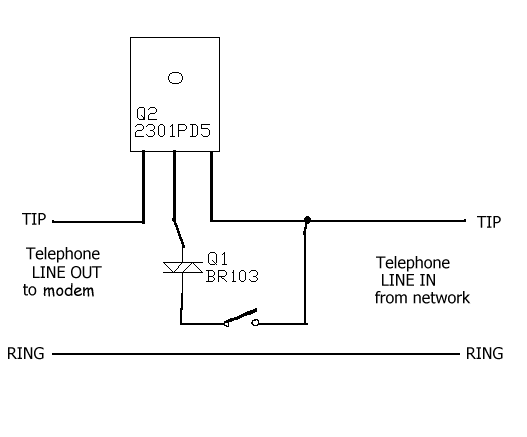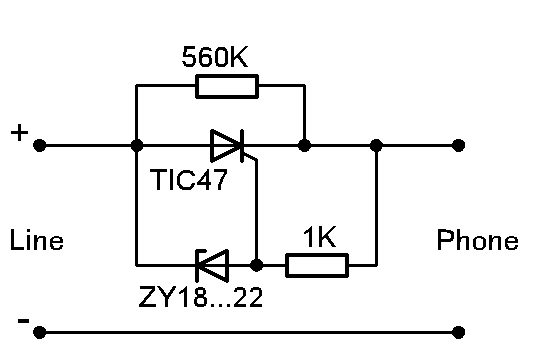Telephone privacy adapter
Design and copyright by Tomi Engdahl 1996 (original design)
Additions to article made January 2005
Summary of circuit features
- Brief description of operation: Prevents telephone call to be heard form other telehones in the same subscriber line
- Circuit protection: Works on both line polarities, no special overvoltage protection
- Circuit complexity: Very simple and easy to build, no need for circuit board
- Circuit performance: Briefly tested with one telephone and telephone exchange
- Operation principle: When one telephone is picked up the circuits prevent other telephones to be picked up (thy do not get any line current).
- Circuit use: Installed between telephone line an telephone. You need one circuit per every telephone.
- Availability of components: Q1 (BR103) is widely available, Q2 might be hard to get
- Design testing: Built quickly from the parts found on my home lab, seemed to work on short test with telephone line simulator and line connected to PBX, I have received a report that this circuit works well in Australia
- Applications: Telephone accessory, stop telephones interrupting your modem calls
- Power supply: No need for extra power supply, takes power from telephone line
- Component cost: Few dollars
- Safety considerations: Should be be built to an insulating case
- Special notes: Not approved to be connected to public telephone network
Circuit description
This circuit is a simple circuit which prevents picking up other telephone when one telephone is in use. This can be done easily by installing this type of circuit between any telephone and the telephone line.
This type of function is very useful when you don't want other people from disturbing your modem connection or listening to your telephone calls by picking up other telephone connected to same line.
The idea of the circuit is to sense the voltage in the telephone line when the telephone is picked up. If that voltage is higher than about 30V (normal on-hook voltages is about 48V) then the circuit lets the telephone to work normally. If the voltage is lower 30V it prevents the current from going to telephone line to telehone (normally the voltage in line is about 6-10V when one telephone is off-hook). The circuit is designed so that is passes the ring voltage to all telephones without problems.
The circuit is very simple circuit built from one DIAC and one TRIAC. When telephone is picked up it will not get any operating current unless the TRIAC Q2 in series with telephone conducts. The triggering of the TRIAC Q2 is done through DIAC Q1, which will trigget the triac if there is more than about 30V voltage between TRIAC Q2 leads connected to telephone line wires. When TRIAC Q2 start to conduct it will conduct as long as there is any current flowing through it. So TRIAC Q2 conducts until the the telehone handset is put on-hook (call has ended).
This circuit is very similar to the operation of commercial adapters, but remeber that this adapter is not type approved for connection to public telephone network. The component values are just what I used in my prototype and you can replace that triac with nearly any type which will handle atleast 200V, can be triggered easily and keeps on conducting at currents as low as 15 mA.
The drawing below shows how to wire the circuit components and the whole circuit to the telephone line.
Modification ideas
I saw one article in sci.electronics.design which mentioned that an article in Elektor Electronics Dec/93 described a similar circuit idea. They used the following components:
- Triac: TIC206D
- Diac: BR100
Q1 BR100 Q2 TIC106D
NOTE: The pinout of TIC206D is different than the one used in the original circuit, so the component connection drawing is different. No wiring drawing of this modified version is available.
Comments on the circuits
AuVIP ([email protected]) has sent me the following comments on
this circuit to me (put here with permission):
"It works. I'm in Australia and it works very well.
Components were either readily available or easily able to be substituted.
Especially the TRIAC."
Other ways to do the circuit
There is one commercion single component designed to do the same as Q1 and Q2 in my circuit. That component is HS20 bilateral silicon switch which consists of zener diode and triac intergrated to same component. A telephone privacy adapter circuit using HS20 has been shown in Electronics Now and Poptronics magazines and that circuit is very simple because that two wire HS20 component is just wired in series with one of the telephone line wires. I have never tested HS20 component, so I can't tell how well it works but I believe that the circuit works because it is published in two magazines. According Poptronics magazine HS20 bilateral switch can be bought for around $4 from:
SolarWorks Grandprarie TX75052According some usenet articles the HS-20 DIACs which are just about impossible to find and they might be discontinued.
The circuit might work with just DIAC
Huw Finney mentioned me that the circuit would work also by using just one normal DIAC in seris with the telephone and not usign any extra components. I have not personally tried it, but with suitable DIAC that might work.
Most diacs are used for pulse generation, probably in the order of amps, and are designed as such. I think the published ratings for static (DC) use are a bit on the consevative side, take a 1N4148 sized diac and say 100 to 200 mW dissipation and about 2V across the diac we are left with 50 to 100 mA, more than enough!
So in engineering sense it seems that just only a DIAC seems to be 'good enough' for this application. I have not personally tested this alternative, but this might be a worth to try.
Commercial circuits is a safe choice
If you rellay need this type of circuis for everyday use I recommend buying a type-approved commercial unit. If you live in Finland and want to buy a ready made commercial unit, go to a shop which sells telephone accessories and ask for PrivaPhone. This commercial unit will cost about 50 Finnish marks (a little over $10). Aastra Telecom makes also quite similar product BusyLine Switch which has also some extra features.
Some additional ideas added 2005:
Modem outgoing call blockign modification
Koltsidas Michael told that there is an usefull modification for different use if you add an on/off switch to the circuit, you can use it to block modem outgoing calls. You just wire the switch in series to the dirac in this way:
When you have built this circuit, you conect the circuit between a standard modem and the telephone line. Then you put the switch to the on position and make the modem to do the modem call to the provider. When the connection is ok, then put the switch to the off positon. The line stays on as long as modem keeps the conenction open.
If an adware or dialer program wants to disconect the modem and call a number, it is imposible, because the the line is cut. Dialling out is possible only when switch is in "on" position.
Other ways to build the same functinality
Miroslav Adzic sent me the following circuit idea that should implement the same operation as my circuit:
Miroslav Adzic told that he spent a day or two testing different variations of the 'privacy circuit' for the telephone line, using several lines and all possible combinations of telephones. None of them (circuits with SCR's, diacs and zeners) seemed to work perfectly under all possible circumstances. According those tests this simple SCR-zener combination shown in the picture suffers only very mild problems (sometimes doesn't turn on right away) ONLY if used on the same line together with an old phone (inductive bell) with no privacy circuit of its own.
The resistors on this circuit can be normal 0.25W models. Zener diode is a low power (400 mW) zener diode with volage rating in 18-22V range.
This circuit design is polarity senstive. A rectifier bridge can be added to secure correct polarity.
Tomi Engdahl <[email protected]>













